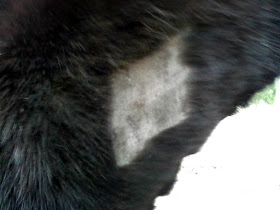I just want to give an update. I'm sorry it took so long. Things have been hectic and busy. Rocky and Chrome are doing great. You can't tell that anything was ever wrong with them except they are a tad thin. These pictures are from Wednesday. I'll get new ones tomorrow if the rain ever stops.
The only picture I got of Chrome. Awkward!
We found someone else to buy hay from. The good thing is he's much closer and it's cheaper. The drawbacks are that the hay is stored outside (with round bales that means you have to peel off about six inches of the outside of the bale) and it isn't pure bermuda, but at this point I'll take mixed grass hay as long as it doesn't have seed heads (it doesn't). They just need the roughage running through their guts to produce heat at this time of year. They get all of their nutrition from their feed and minerals.
Zep and the goats still haven't shown any signs of the staggers. I'm so glad they had the sense not to eat it! Smart boys!
Blissed out over their mashes.
Rocky's shaved neck where the IV was.
Hopefully I'll be able to get some pictures tomorrow to give you an update on how they look now. Like I said above these pictures are from Wednesday.
Oh and they got their hooves trimmed in the dark last night lol. I can't wait for the days to get longer!!!!
I also want to share a comment that Mrs. Shoes left on my last post because it has a lot of great information in it!
"I'm very glad to hear that the horses will be okay & that you were able to identify the cause of their sickness - isn't it funny that Zep & the goats instinctively wouldn't eat that bad hay? I thought that goats would eat just about anything, but I guess that is a misconception.
I really want to say Thank You! for writing about this, because prompting awareness & getting us all thinking about the quality of our pastures or hay is of real value.
I'd heard of Ergot Poisoning before but in rye. Now I know that it can also be a problem in triticale, wheat, & barley crops; but I didn't know that brome & couch grass are also extremely susceptible to ergot infection, or that there are no effective fungicides against ergot.
I read that Dallis grass is fairly common in the southern US (having come up from Central America), but everywhere has potential problem plants. Here we walk our pastures to monitor for & eradicate any traces of Bloodroot (which is related to the poppy & has gorgeous white flowers) & Nightshade - which are both deadly. Since some chemicals can be dangerous to the stock too, we use a sharp tool to dig out bad plants & all the roots we can find. Then we haul them up to the yard & lay them out on some concrete where I then douse them in white vinegar & leave them in the burning sun until they are withered & dry. Then we seal them up in garbage bags & take them to the dump.
We don't take the chance of just burning anymore (because) one year we had been burning tree branches that had a fungus on them, only to find out later that burning Black Knob fungus just releases spores into the air to cause more problems.
For anyone who might not know what plants to beware of in their area, type in Toxic Plants in 'Wherever' & it should lead to a detailed list with photos of the bad plants.
Where I am from, Rabies SO wasn't a problem that the vets didn't even recommend vaccinating against it; but where I live now, it IS a problem & ALL the animals have to be vaccinated, including our horses & cattle.
I wonder what steps your hay producer will be taking to ensure he doesn't sell hay that can kill his customers. i found the following control tips listed at http://www.gov.mb.ca/agriculture/crops/plant-diseases/ergot.html
Delay swathing in headland areas to allow strong winds to shake out the ergots from standing grain. Harvest these swaths separately because they are likely to have the highest ergot contamination.
Use good sanitation. Cut or burn nearby grasses before they come into head. Clean seed to remove ergot bodies. If a few ergot bodies remain in the seed, plant at least 5 cm (2 in.) deep or store seed for one year to reduce the viability of ergot bodies to almost zero. Cultivate deeply after a crop has been infected with ergot to bury the sclerotia at least 2.5 cm (1 in.) below the soil line or rotate to a resistant crop. Do not sow wheat after rye.
Leave at least one year between susceptible crops, ie. rye, triticale, wheat and barley. Note that brome and couch grass are extremely susceptible to ergot.
There are no resistant varieties or effective fungicides. Test soils for copper availability. If copper levels are less than 1 ppm, it may be necessary to apply copper fertilizer to the soil to reduce this disease in wheat and barley."







So happy they're doing well!
ReplyDeleteGlad to hear everyone is doing well! Curious to hear what you think of Cool Calories :)
ReplyDeleteI'll definitely let you know. :D
DeleteI'm glad they are feeling better!
ReplyDeleteI'm glad they are doing better!!!
ReplyDeleteThanks everyone!
ReplyDelete